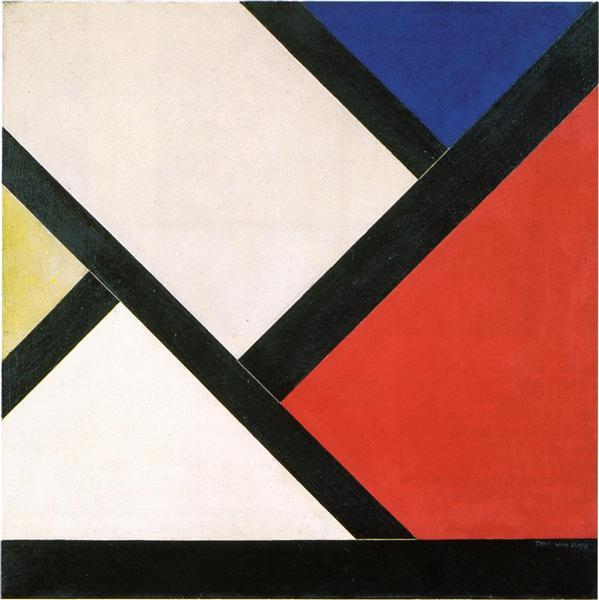Description
The work "Composition of counter XIV" (1925) by Theo Van Doesburg is a significant example of his exploration of neoplasticism, an artistic movement that he himself helped to define. Van Doesburg, co -founder of De Stijl, sought the synthesis of art and life through a rigid and rational aesthetic that emphasizes abstraction and geometrization. In this painting, the artist displays a compositional structure in which formal elements reach a dynamic balance between order and disruption, reflecting their ideas about modernity and visual perception.
At first glance, the work is characterized by a variety of geometric shapes, predominantly rectangles, which are distributed in a plane. Clear contours and vibrant colors such as intense yellow, blue and red create a sense of movement and depth, while suggesting a sense of architecture. This manipulation of color and shape is a distinctive characteristic of Van Doesburg's work, who often used a palette that evoked the luminosity of artificial light, thus reflecting the industrialization of the modern world. The colors are not only found on the surface, but they seem to interact with each other, generating a visual experience that invites the viewer to an active contemplation.
However, in "Composition of counter XIV" human figures or characters are not perceived in a traditional sense. On the other hand, the absence of the figurative opens the question of the relationship between the viewer and the work, promoting a connection that transcends the representational. This choice can be seen as a comment on dehumanization in modern society, where human interaction is eclipsed by environments dominated by design and geometry.
The work is in a temporal and stylistic context that reflects the transition between pure abstraction and the inclusion of more narrative elements in painting. It is contemporary to other productions within the STIJL movement and the variations of Piet Mondrian, although Van Doesburg was differentiated by its greater openness to experimentation and the relationship of painting with architecture and design.
Beyond its immediate visual impact, "composition of the XIV counter" encapsulates the spirit of time an era of change, innovation and, often, of bewilderment before modernity. Van Doesburg, through its countercurrent approach, challenges the viewer not only to observe, but also to investigate the layers of significance that emerge from the confrontation between order and chaos. In this sense, the work invites us to reflect on our own existence within an increasingly abstract and stripped environment of tradition, a theme that resonates powerfully in contemporary art.
In conclusion, "Composition of the XIV counter" is not only a colored and shape deployment, but a testimony of a crucial moment in art history, where the visual becomes a vehicle for the exploration of complex ideas about space, the perception and the place of the individual in an evolving world. Theo Van Doesburg, through this work, not only establishes a dialogue with its time, but also invites us to reconsider our own relationship with the art and the environment we inhabit.
KUADROS ©, a famous paint on your wall.
Hand-made oil painting reproductions, with the quality of professional artists and the distinctive seal of KUADROS ©.
Art reproduction service with satisfaction guarantee. If you are not completely satisfied with the replica of your painting, we refund your money 100%.

